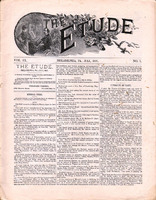BY J. W. ANDREWE.
The work of piano-forte teaching may be divided into two parts, to wit, the technical and the musical.
All that pertains to music, aside from the means used in its production, is considered as purely musical and distinct from the technical.
The fundamental basis of all piano music, technically considered, is the playing of the various kinds of passages and chords in a proper manner, with a correct position of the arms, wrists and hands, including well- finished tone production, under the control of the inner artistic sense of the performer. It is through these channels alone that the artist can express his musical thoughts upon his instrument. Hence, if one would express himself clearly he must not neglect these very necessary essentials.
Therefore, an early knowledge of and ability to perform the scales, chords and arpeggios becomes necessary. An understanding of the structure of the scale, as composed of its two tetrachords in its triple relationship of tonic, dominant and sub-dominant harmonies, should early be imparted to the pupil, as well as why these relationships exist. Afterward it will be easy to acquaint the student with the plegel (sic), authentic and complete cadences, and he can be made to readily understand the dominant as the foregoing chord of the major and minor keys. After a thorough knowledge of the major heads has been given, the minor should be undertaken, care being taken not to confuse the mind of the student with trying to impart too much of the lesson without
depending upon future repetition to make the subject familiar. If the matter of these relationships can be made plain to the mind of the student, you have already awakened his interest in music. "To interest as well as to instruct" is a wise motto for a teacher to adopt. In this way only can you hope to arouse enthusiasm, which is essential to success. I am conscious that undue enthusiasm with a restless ambition, unaccompanied by great patience, is often productive of much work that must be undone, thereby causing a loss of a double amount of time that a correct conception at the beginning would have saved. The pupil should learn to know on paper, as well as on the keyboard, the position of the common chord. This work must be conducted by the teacher until the pupil acquires the desire of improvement for himself. In this way, new fields will quickly open in which will be derived much pleasure and profit. After the pupil has become somewhat skilled in the difficult parts, and has acquired a good knowledge of the sept chords, he will find much of value in the study of acoustics, and such works as "New Lessons in Harmony," by Fillmore, etc.
All those I will classify under the head technical, because they must be learned as a technical aid to music. Of course, it is largely in the domain of harmony, but I do not see how a person can be an intelligent musician, much less a teacher, without some knowledge of this important branch of musical training. Musical form cannot be understood, nor can you express ideas to your musical students without using terms used in the study of harmony. Furthermore, a chord expresses a definite object as much as the word letters express clauses and sentences in the literature of their component counterpart in the notes, germs, motives, phrases and periods in music.
We ought to teach our pupils so that they can instantly perceive in all its different aspects wherever it occurs. We know a word at sight, without being conscious of seeing its individual letters. Why should not a chord be as quickly noted? Practice will enable us to do this, and will assist the slow reader in a marked manner.
This means, of course, earnest mental endeavor. Thus, in the study of musical form later on, the knowledge of harmony gained in the past becomes of great service in the assisting to a clearer understanding of the matter.
It also aids in making intelligent musicians, and should there be the little spark of genius within the breast of the aspiring student, such knowledge will help it to spring forth.



